

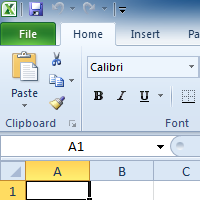
Excel is a spreadsheet program that allows you to store, organize, and analyze information. In this lesson, you will learn your way around the Excel 2010 environment, including the new Backstage view, which replaces the Microsoft Office button menu from Excel 2007.
We will show you how to use and modify the Ribbon and the Quick Access toolbar, as well as how to create new workbooks and open existing ones. After this lesson, you will be ready to get started on your first workbook.
The Excel 2010 interface is similar to Excel 2007. There have been some changes we'll review later in this lesson, but if you're new to Excel first take some time to learn how to navigate an Excel workbook.
Click the buttons in the interactive below for an overview of how to navigate an Excel workbook.
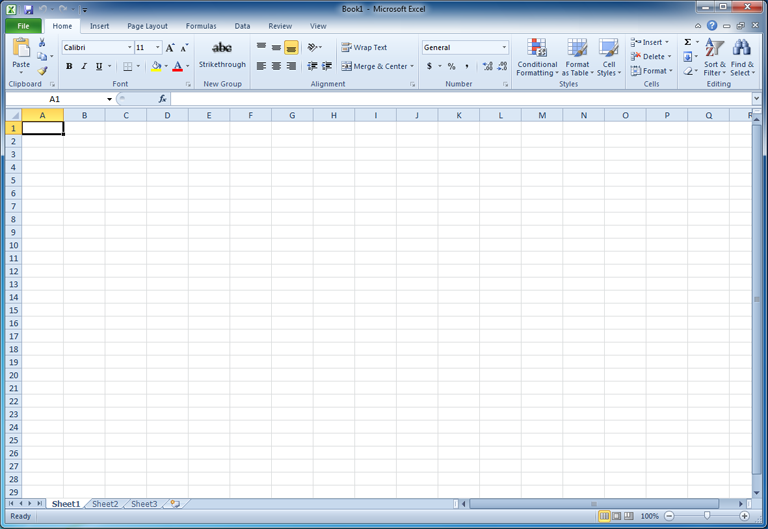
A row is a group of cells that runs from the left of the page to the right. In Excel, rows are identified by numbers. Row 15 is selected here.

The name box tells you the location or the name of a selected cell. In the image below, cell B4 is in the name box. Note how cell B4 is where column B and row 4 intersect.
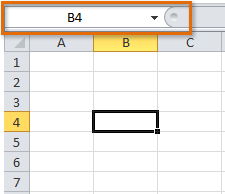
The Quick Access toolbar lets you access common commands no matter which tab you are on. By default, it shows the Save, Undo, and Repeat commands. You can add other commands to make it more convenient for you.
![]()
Click and drag the slider to use the zoom control. The number to the left of the slider bar reflects the zoom percentage.

There are three ways to view a spreadsheet. Click a page view button to select it.
• Normal view is selected by default and shows you an unlimited number of cells and columns. It is highlighted in this image.
• Page Layout view divides your spreadsheet into pages.
• Page Break view lets you see an overview of your spreadsheet, which is helpful when you're adding page breaks.
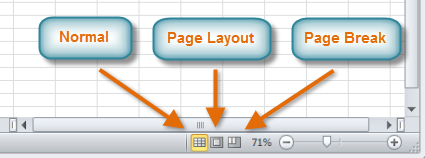
You may have more data than you can see on the screen all at once. Click and hold the horizontal scroll bar and slide it to the left or right depending on which part of the page you want to see.
![]()
Excel files are called workbooks. Each workbook holds one or more worksheets (also known as spreadsheets).
Three worksheets appear by default when you open an Excel workbook. You can rename, add, and delete worksheets.
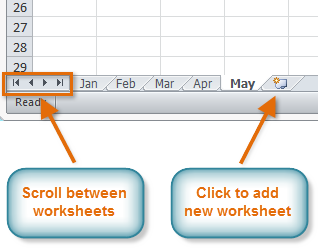
In the formula bar, you can enter or edit data, a formula, or a function that will appear in a specific cell. In this image, cell C1 is selected and 1984 is entered into the formula bar. Note how the data appears in both the formula bar and in cell C1.

A column is a group of cells that runs from the top of the page to the bottom. In Excel, columns are identified by letters. Column L is selected here.

The Ribbon contains all of the commands you will need in order to perform common tasks. It has multiple tabs, each with several groups of commands, and you can add your own tabs that contain your favorite commands. Some groups have an arrow in the bottom-right corner that you can click to see even more options.

The Ribbon and Quick Access toolbar are where you'll find the commands you need to perform common tasks in Excel. If you are familiar with Excel 2007, you will find that the main difference in the Excel 2010 Ribbon is that commands such as Open and Print are now housed in Backstage view.
The Ribbon contains multiple tabs, each with several groups of commands. You can add your own tabs that contain your favorite commands.
 The Ribbon
The RibbonYou can customize the Ribbon by creating your own tabs that house your desired commands. Commands are always housed within a group, and you can create as many groups as you need to keep your tabs organized. You can also add commands to any of the default tabs as long as you create a custom group within the tab.
 Right-clicking the Ribbon to customize it
Right-clicking the Ribbon to customize it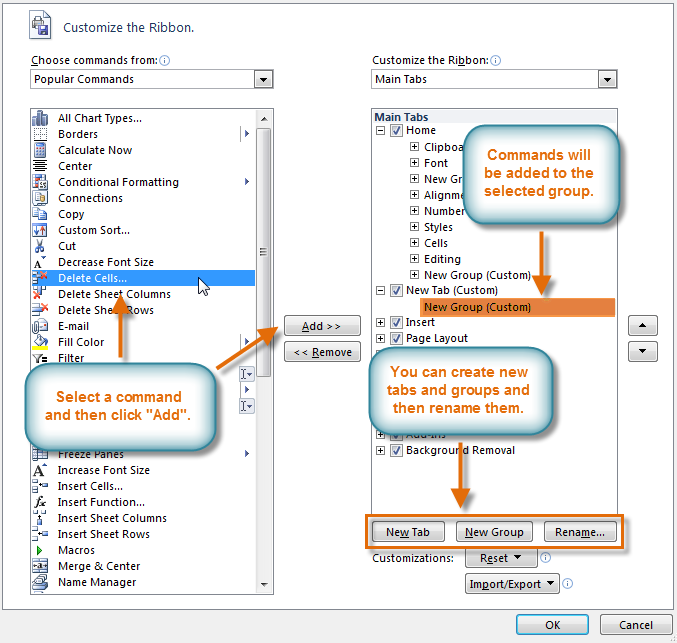 The dialog box where you can customize the Ribbon
The dialog box where you can customize the RibbonIf you do not see the command you want, click the Choose commands drop-down box and select All Commands.
 Displaying All Commands
Displaying All CommandsThe Ribbon is designed to be easy to use and responsive to your current tasks; however, if you find that it's taking up too much of your screen space, you can minimize it.
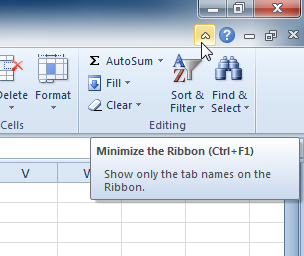 Minimizing the Ribbon
Minimizing the RibbonWhen the Ribbon is minimized, you can make it reappear by clicking a tab. However, the Ribbon will disappear again when you're not using it.
The Quick Access toolbar, above the Ribbon, lets you access common commands no matter which tab you are on. By default, it shows the Save, Undo, and Repeat commands. You can add other commands to make it more convenient for you.
 Adding a command to the Quick Access toolbar
Adding a command to the Quick Access toolbarBackstage view gives you various options for saving, opening a file, printing, and sharing your document. It is similar to the Microsoft Office button menu from Excel 2007 and the File menu from earlier versions of Excel. However, instead of just a menu it's a full-page view, which makes it easier to work with.
 Backstage view
Backstage viewClick the buttons in the interactive below to learn about the different things you can do in Backstage view.

Here, you can change various Excel options. For example, you can control the spelling and grammar check settings, AutoRecover settings, and Language preferences.

From here, you can access Microsoft Office Help or check for updates.

Save & Send makes it easy to email your workbook, post it online, or change the file format.
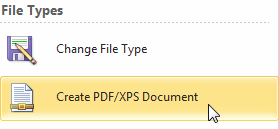
From the Print pane, you can change the print settings and print your workbook. You can also see a preview of your workbook.

From here, you can create a new blank workbook, or you can choose from a large selection of templates.

Familiar tasks such as Save, Save As, Open, and Close are now found in Backstage view.
Info contains information about the current workbook. You can also inspect and edit its permissions.

For convenience, recent workbooks will appear here.
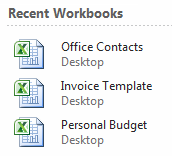
Excel files are called workbooks. Each workbook holds one or more worksheets (also known as spreadsheets).
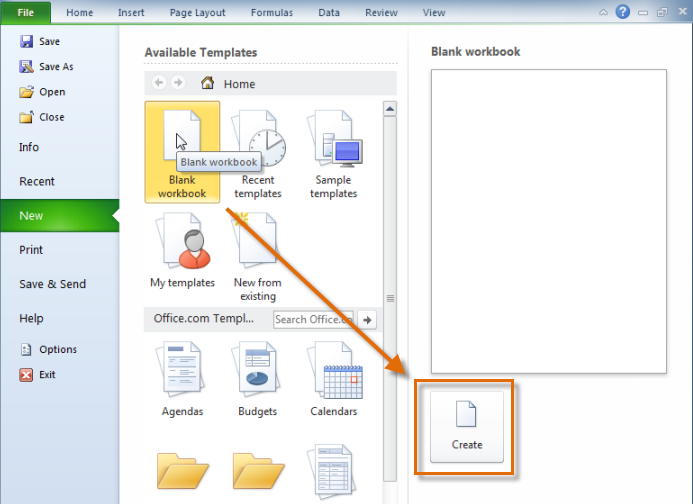 Creating a new workbook
Creating a new workbookTo save time, you can create your document from a template, which you can select under Available Templates. We'll talk more about this in a later lesson.
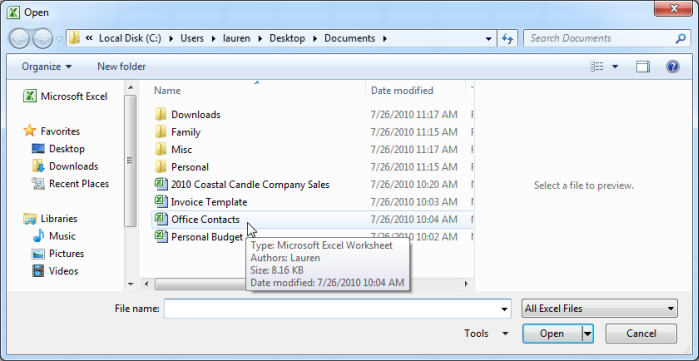 Opening a workbook
Opening a workbookIf you have opened the existing workbook recently, it may be easier to choose Recent from the File tab instead of Open to search for your workbook.
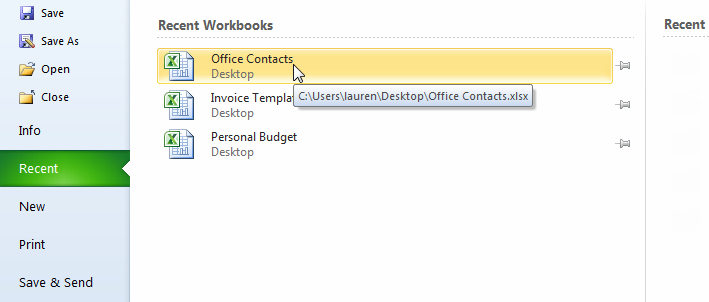 Opening a recent workbook
Opening a recent workbook
Sometimes you may need to work with workbooks that were created in earlier versions of Microsoft Excel, such as Excel 2003 or Excel 2000. When you open these types of workbooks, they will appear in Compatibility mode.
Compatibility mode disables certain features, so you'll only be able to access commands found in the program that was used to create the workbook. For example, if you open a workbook created in Excel 2003 you can only use tabs and commands found in Excel 2003.
In the image below, the workbook has opened in Compatibility mode. You can see that the sparklines and slicers features have been disabled.
 Disabled commands in Compatibility mode
Disabled commands in Compatibility modeTo exit Compatibility mode, you'll need to convert the workbook to the current version type. However, if you're collaborating with others who only have access to an earlier version of Excel, it's best to leave the workbook in Compatibility mode so the format will not change.
If you want access to all of the Excel 2010 features, you can convert the workbook to the 2010 file format.
Note that converting a file may cause some changes to the original layout of the workbook.
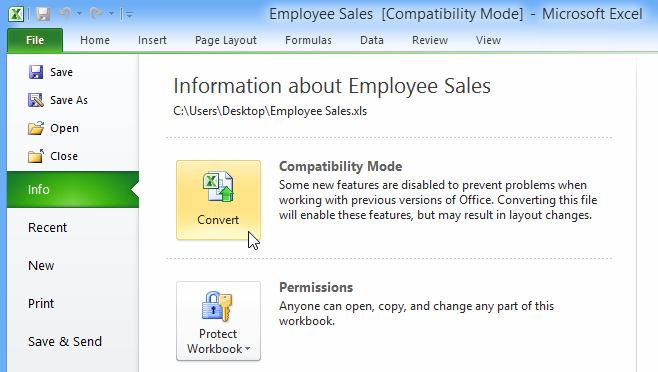 Converting the workbook to the newest file type
Converting the workbook to the newest file type Saving a new version of the workbook
Saving a new version of the workbook
/en/excel2010/cell-basics/content/